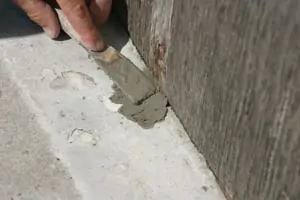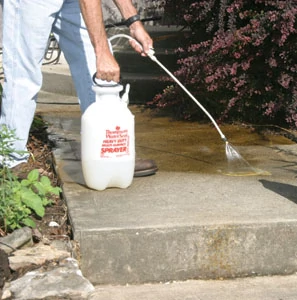Moisture is a serious threat to the longevity of your home. In the form of rainwater and ground seepage, it can ruin foundations, windows and doors, masonry and cement, siding and roofs. Excess moisture can also create serious mold problems, and is quite common in basements and crawlspaces. However, it can occur above ground as well, due to roof and gutter leaks. Sealing out moisture and waterproofing your home is the most important maintenance chore you can do.
Moisture is the biggest culprit to the longevity of your home. In the form of rainwater and ground seepage, it can ruin foundations, windows and doors, masonry and cement, siding and roofs. Excess moisture can also create serious mold problems, and is quite common in basements and crawlspaces. However, it can occur above ground as well, due to roof and gutter leaks. Sealing out moisture and waterproofing your home is the most important maintenance chore you can do.
First Things First
The first step in eliminating moisture is to control roof runoff. Clean out and repair gutters on a regular basis. Make sure all downspouts are connected. If possible connect downspouts to buried drainpipes. Or extend downspouts at least 4 feet away from the house and install a splash block to help disperse the water. Downspouts that discharge too closely are just injecting water into the basement. Arrange the soil located around the foundation perimeter so it slopes away from the house to keep rainfall from collecting against foundation walls. Trim overgrown bushes and trees; heavily overgrown bushes and trees can prevent good drainage and lead to foundation leaks.
Above and Below:First step is to thoroughly caulk all windows, doors,around pipes, vents, roof flashings and other areas.Next, seal inside and outside cracks and around pipeopenings with a quick-setting sealant, such as UGL DRYLOK Water Plug.
Then caulk, caulk and caulk. Adding caulking around windows, doors, roof flashings and other points of entry is the easiest and most economical sealing and waterproofing chore. Make sure you use a caulk suited to the application. DAP ALEX PLUS Acrylic Latex Caulk Plus Silicone is a high-grade caulk with silicone added to the latex formula to improve adhesion and flexibility. The caulk is multi-purpose, flexible, highly durable and even paintable after it dries tack-free in 30 minutes. The product is also treated with a fungicide to prohibit mildew build-up once it cures, and it is available in 10 colors.
For outside crack, chip an inverted “V” shape in the crack in order to hold the material in place.
Then mix the material and force it into the crack. Smooth with a trowel.
Use Water Plug products to seal any cracks between a concrete floor and the walls.
In the Basement
If you have a basement, the next step is to completely seal and waterproof it. Or in the case of a basement or foundation with cracks or seepage, first seal and repair any cracks, openings around pipes and other areas. A good product for this chore is UGL DRYLOK Fast Plug. Using a masonry chisel, back chisel out the crack or area to create an inverted “V” to help lock the material in place. Use a wire brush to brush away any loose or crumbly material. Wet the area thoroughly, and then mix only enough material to use in 3 to 5 minutes as the material sets extremely fast, even when water is flowing actively through the crack or hole. Apply the material with a putty knife or trowel and smooth the surface. If an active area, force the material in place against the water and hold with a trowel or knife until it sets. Another area that should be sealed is at the floor and wall joints. As concrete cures, it typically shrinks, allowing the floor to pull away from the wall and creating a water entryway. Clean the area thoroughly, then wet down with water and apply UGL DRYLOK Fast Plug to all gaps between the walls and the floor.
In many instances the first step is to clean the concrete surface. Thompson’s Concrete Care Cleaner & Degreaser is applied with a pump-up sprayer.
Sealing Concrete
Thompson’s Water Seal Company has a full line of concrete and masonry sealing products. The company’s Concrete Care Cleaner & Degreaser can be used on concrete, brick, stucco or stone and removes oil, grease, dirt, mildew, algae and mold. The product comes ready-to-use and can be applied with a pump-up sprayer or a plastic garden watering can.
After 10 to 15 minutes the area is scrubbed with a stiff bristle brush.
When using cleaners, protect all plants with a plastic drop cloth. Do not allow the product to contact painted surfaces, and wear eye protection, rubber gloves and long clothing. Allow the material to work for 10 to 15 minutes, then scrub with a stiff natural or synthetic, not metal or wire, brush. Allow another 10 to 15 minutes, and then wash off with a garden hose or pressure washer. Make sure all residue is removed and saturate the ground around plants and shrubs with fresh water.
Above and Below:Then the area is flushed with water using a hose or pressure washer to remove all dirt, grime and debris.
Apply a top coat of concrete sealer.
Once the surface has been thoroughly cleaned, apply a concrete sealer. Thompson’s Concrete Care Sealer may be used on exterior concrete, brick, stucco and stone, and prevents water damage, resists chipping and cracking, and provides resistance to damage from freeze/thaw cycles. It also protects against de-icing salts and pool chemicals.
For freshly poured concrete, allow 30 days before applying and be sure that air and surface temperatures are above 40 degrees. Thoroughly sweep the new concrete of all dust, debris or loose materials. Clean the surface with concrete cleaner and degreaser. Again, cover all plants and shrubs and then apply the sealer on horizontal surfaces with a brush, roller or plastic pump-up sprayer. The product is a one-coat material.
If you desire to add color, use Thompson’s Water Seal Concrete Care 100% Acrylic Latex Stain to provide a long-lasting, scuff-resistant coating that prevents water damage.
Add Some Color
If you prefer to add color, you can use Thompson’s Concrete Care 100-percent Acrylic Latex Stain. It can be used on any exterior or interior concrete or masonry surface, and provides a long-lasting, scuff-resistant coating that protects against flaking and peeling, prevents water damage and can be used on any exterior or interior concrete or masonry surface. It comes in a variety of fade-resistant colors.
Due to the nature of concrete, it’s extremely important to properly prepare the surface. Clean surface as necessary, using the concrete cleaner and degreaser. If staining a smooth concrete surface, it may be necessary to first use Thompson’s Concrete Care Pre-Stain Etch. This will create a texture similar to 80-grit sandpaper. Make sure to sweep and rinse away all dust created by the etching process. Do not apply in direct sunlight or on hot days. Apply using an exterior paint pad, brush, roller or compression driven sprayer set for low pressure. Keep the leading edge wet and distribute the stain evenly. This will help avoid lap marks and keep the color uniform.
Interior basement walls can be sealed and waterproofed using UGL DRYLOK. This thick formula is applied in two coats, first with a brush, then with a roller.
Another product is the UGL DRYLOK in either latex or oil base. This is a thick-bodied masonry sealer formulated to provide a waterproof barrier. It should be applied in two coats for maximum protection. Apply the first coat with a stiff bristle brush, working the product deeply into the masonry pores.
Waterproofing sealers should also be applied to exterior wood surfaces as well. These can be semi-transparent sealers, or you may prefer to use a combination sealer/stain.
Sealing Wood
Wood surfaces, such as decks, sidings, trim and others should also be sealed for water protection. Thompson’s Clear Multi-Surface Waterproofer prevents water damage and can be used on decks and fences, brick patios, concrete driveways and other exterior surfaces. It beads and waterproofs, but allows wood to weather to a natural gray.
When sealing wood, surfaces must be free of all mildew, dust, dirt, oil, soot, grease and other contaminants. Apply wood sealer with a brush, roller, sprayer or by dipping. A garden pump-up sprayer is the simplest method. Cleanup is with mineral spirits.
One of the more interesting wood sealers is the Sikkens brand Rubbol Siding Finish. It has an innovative hybrid/acrylic formulation, specifically engineered to provide the advantages of both oil- and water-based coating. The hybrid formula combines the quality of an oil-based coating with the ease-of-use of a water-based solution. It is recommended for exterior surfaces, such as siding, shakes, shingles, fences, log siding, cedar, pine, spruce, fir or exterior plywood (such as T-1-11 board). It excels in covering weathered surfaces and is available in 53 colors.
Don’t let water damage your investment. Sealing and waterproofing chores are fairly easy, but can go a long way to protecting your home and keeping it looking sparkling and attractive as well.
















